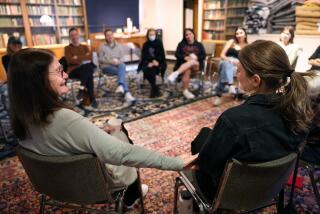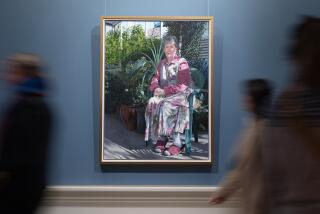Ireland Saying a Slow Goodbye to Traditional Farewell to Dead
DONEGAL, Ireland — Pray for it, mourn for it, keen for it. Alas, even lift a jar to it. The old Irish wake is slowly dying.
Indeed you’d have to go deep into the Gaeltacht, the Irish-speaking areas of Connemara, and the Aran and Tory islands off the wild Atlantic Coast, to hire professional keeners--women in black shawls--to moan and wail for the passing of this venerable burial rite, a boisterous blend of piety and hospitality.
At some wakes nowadays, you might get only a cup of tea from the grieving family, much less a jar of whiskey, a pint of Guinness or a clay pipe, which began going out with the government health warnings against tobacco.
The traditional Irish wake where, as folklorist Padraic O’Farrell of Mullingar notes, “the barrel of porter, the tray of clay pipes and similar hospitality equaled respectability in the eyes of the neighbors,” has become the victim of liturgical reform, the high price of a pint and what the Rev. James Walsh, a retired priest in County Limerick, denounces as “that blasted American abomination, the funeral parlor.”
The late Brendan Behan, a noted all-night mourner and storyteller at many a wake in the slums of north Dublin, could agree with His Reverence there. In “After the Wake,” he writes about having more than a few “sob gargles” sitting up with the corpse of a young neighbor “laid out in the blue satin gown of the Children of Mary sodality.” About 3 a.m., the playwright “fancied her looking up from the open coffin on the Americans who, having imported wakes from us, invented morticians themselves.”
Hugh McGovern, an undertaker “for 50 years come next June, God willing,” in Letterkenny, County Donegal, says that funeral parlors like his “have sprung up almost overnight all down the coast to Limerick and Kerry. However, people in the countryside around here don’t much go for it. They stick to the old-time setup of a two-night wake in the house.”
The social side of Irish grief, he admits with a sad shake of his balding head, “is not at all like it used to be. Now you might get the odd sip of whiskey, privately in the back room. Well, I suppose the entertainment was getting a bit out of hand in recent years, leading to what you might call all kinds of involvements, fights and all that. So the church stepped in and cooled it.”
A number of Irish-Catholic dioceses now require that the body be brought into the church the night before burial.
“It’s compulsory here in Mayo,” says sexton Pat Cobbe at St. Mary’s Parish in Westport. “The bishops maybe thought this might cut down on the drinking in the wake house, but sure now don’t many go straight from the chapel to the pub for the final farewell?”
Cobbe thinks “the price of a pint, now a shocking 2 punts (the Irish pound valued at U.S. $1.60), has done more to curb the conviviality” than any ecclesiastical reforms.
Living near the Northern Ireland border, undertaker McGovern has buried both Catholic and Protestant victims of Ulster’s lingering violence. On Tuesday evenings, “as a relief from all that,” he plays “the fiddle and the spoons” with a group of traditional Irish musicians at a local hotel bar.
McGovern can remember wakes in the rural west of Ireland where “singing and dancing were part of the grieving. It was a good-humored way of helping the family over their bereavement.”
Nobel laureate William Butler Yeats, in his Irish folklore collection, recounted the lively obsequies for Michael Morgan, the celebrated blind Dublin ballad singer. Fiddlers, accordionists and street singers from miles around “gave him a fine wake. He had had his day, had said his prayers and made his confession, so why should they not give him a hearty send-off?”
Although the lugubrious Irish landscape of lichen-pocked Celtic crosses, 5,000-year-old burial mounds, prehistoric table tombs of huge balanced rocks (called dolmens), and tumbledown tombstones in every country churchyard is a constant reminder of death, the religious convictions of the people that the soul lives on and will one day be reunited with the body robs death of its gloom and futility.
The Irish do not go gentle into that good night. They revel against the dark. Centuries before Vatican I did away with the Requiem Mass, black vestments and tall candles to put the emphasis on eternal life in the new rite of Christian burial, the Irish had their own bright vision of life’s inevitable conclusion. They looked upon death as a time to console and cheer up the sorrowing family, who hosted the celebration of life after death by providing the food and drink.
“A quiet wake would be a poor reflection on the corpse,” observed Mae Herrity, who presides over the “Town View B & B,” a bed and breakfast in Letterkenny. “The old Irish wake may be in extremis, but it’s not stretched yet,” meaning not laid out for burial.
“Nowadays, tea, sandwiches and cigarettes might be offered until the priest came to say the rosary,” Herrity expanded on her theme. “Once the priest was out of the way, the whiskey would be going and flowing all night. My uncle died about three years ago and was waked at my mother’s house next door. A cousin pronounced it ‘the best weekend I ever had. I drank all night for free and never sobered.’ ”
Embalming is not required by Irish law, but a growing majority die in hospitals where embalming is routinely done at the morgue. The Catholic Church now permits cremation, but the practice is not common. Facilities are available only in Dublin, Belfast and Cork.
If the wake is in the house, sitting up all night with the corpse is still an emotional element in the Irish way of death.
“You never leave the corpse on its own,” said Michael Murphy, an insurance agent in County Louth, who has sat up with many a corpse in his 45 years. “I sat up with Mick Riley, Rose Riley, Tom McKeown, Mrs. Mackin, and others.”
Murphy outlined the protocol for the nightlong vigil: “Those leaving are gone by 1 o’clock. Those sitting up arrange themselves around the coffin. The tea would be made, and generally there would be a bottle of whiskey, some Guinness and beer, provided by the family.”
The mourners “recite a decade of the rosary (10 Hail Mary’s and one Our Father) then talk about what a fine person the deceased was and isn’t it a lovely looking corpse?”
Even if the departed was the worst of rogues, someone would be sure to say, “Ach, with all his faults, he was a decent old skin.”
After another decade of the rosary, Murphy continued, “you might talk about the best wake you were ever at and whether the deceased was a great one for attending wakes and good at telling tales about the fairies, the wee people.
“Later you might discuss the weather or football results or what’s to become of the family now. As the night wears on, the craic [conversation] gets livelier. The ghost stories and the jokes go around with the bottle. The longest part of a wake is from 4 a.m. on. About dawn, you might stretch your legs, but someone always stays by the coffin.”
And, he added, “You must always leave a window open in the room with the corpse.”
The Rev. Lorenzo Cleary of County Wexford explained that old custom: “When I was a lad, a window was left open to let the soul fly to its creator.”
In olden days, down to World War II, tongue-twisters and simple parlor games like “My Man Jack” and “Marrying Out” were used to stave off sleep.
Michael Murphy doesn’t recall dancing or games at any wakes in his time, but he does remember “the women handing out clay pipes, shags of tobacco and lashings of food and whiskey even in the poorest of times. No matter how hard-pressed, people always find money to provide refreshments. Otherwise they’d be looked on very bad.
“It’s a matter of status, family pride. You might spend the rest of your life paying for a wake.”
Often in bygone days and sometimes still, a total stranger, seeing a wreath on the door, would stop by to pay his respects to the unknown dead and partake of whatever was offered. The meandering mourner might luck out and be treated to “a drop o’ the quare stuff”--poteen or illegal whiskey distilled in the bogs that reputedly “goes down the throat like a torchlight procession.”
Irish death rituals are strangely intertwined with “pisthogues,” old superstitions that acknowledge the presence of the spirit world. John Campbell of Mullaghbawn in County Armagh, a noted scealai or storyteller who has lectured at a number of American universities, cited a few:
* Clocks in the wake house are stopped and all mirrors in the house turned to the wall or covered with a white cloth.
* The unpaid gravediggers, usually close neighbors, are rewarded with a pint of whiskey apiece and given first choice, after the women who washed the corpse, of the dead person’s clothing, brogues (boots) or a favorite chair or holy picture.
* The deceased’s personal effects--comb, soap, toothbrush, shaving mirror, cosmetics, etc.--are buried in the garden, preferably “under an elderberry bush.”
* One should never leave a wake house unaccompanied or take a shortcut across the fields.
* A gap in the funeral cortege, to allow traffic or a herd of cows through, forecasts an imminent death among the mourners.
* A rainbow over an open grave is an omen that someone living within the arc will be waked before the year is out.
After the coffin is removed, the “wake table” is overturned to keep death from the door.
Other superstitions have died out with the old storytellers who, as Campbell laments, “lost their place at the fireside when TV came along.” Hardly anyone anymore stirs the milk with the dead person’s hand to make the butter richer. Being attracted to someone of the opposite sex across an open grave no longer means you must marry soon or pine alone ever after.
The death of the Irish wake could be a near-fatal blow to the country’s writers. From Brian Friel and Seamus Heaney, down through Sean O’Casey, George Bernard Shaw and Oscar Wilde, back to the Celtic bards keening for the high kings on the Hill of Tara, Irish literature has been rich in rollicking, not quite irreverent, renditions of life’s final curtain scene.
Who can forget Kate Cassidy’s wake in John Millington Synge’s “Playboy of the Western World,” where “you’d never see the match of it for flows of drink, the way when we sunk her bones at noonday in her narrow grave, there were five, aye six, men stretched out retching speechless on the holy stones”?
Or the wake scene in the film version of Liam O’Flaherty’s “The Informer,” which won Academy Awards for John Ford and Victor McLaglen?
“The wake is a grand review of family ghosts,” wrote novelist Seamus O’Kelly. “There one hears all the stories, the little flattering touches, the little unflattering bitternesses, the traditions, the astonishing records, of the clan. The woman with a memory speaking to the company from a chair beside a laid-out corpse carries more authority than a bishop allocuting from his throne.”
James Joyce regarded the Irish American music hall song “Finnegan’s Wake” as a comic and profound statement on the fall of man and his resurrection after partaking of “usquebagh”--the elixir of life. Finnegan, a hard-drinking hod carrier, ascends the ladder with a load of bricks and falls to his death, but revives when the whiskey is passed around at his wake.
Joyce immortalized the ditty as the title of his last, most enigmatic novel.
As the song says, “Lots of fun at Finnegan’s Wake.” Funereal fun of a unique and strangely devout cultural tradition that, with changing times, is slowly but surely being carried on the shoulders of a fading generation to the lush green graveyard of Irish history.
More to Read
Sign up for Essential California
The most important California stories and recommendations in your inbox every morning.
You may occasionally receive promotional content from the Los Angeles Times.










